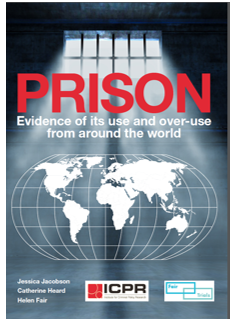
Overcrowding, inhumane and degrading detention conditions and disproportionate harm to marginalised groups are some of the consequences of the rapid, unrelenting growth of imprisonment worldwide, according to Prison: Evidence of its use and over-use from around the world, published today [16 March] by the Institute for Criminal Policy Research (ICPR), Birkbeck, University of London, and the NGO, Fair Trials.
The report can be downloaded here
The report, by Jessica Jacobson, Catherine Heard and Helen Fair, draws on ICPR’s unique World Prison Brief database and describes patterns and trends in imprisonment in ten contrasting countries across all five continents. Each of the ten countries has a different story to tell about its use of imprisonment:
- The United States has around one-fifth of the world’s prisoners. Its prison population more than quadrupled from around half a million in 1980 to a peak of over 2.3 million in 2008.
- Brazil has seen prisoner numbers increase twenty-fold from around 30,000 in 1973 to over 600,000 today. Many prisons are under gang control. Riots, extreme violence and massacres are regularly reported.
- England and Wales has seen its prison population more than double since 1975. Incidents of violence, suicide and self-harm are at a record high and there were four prison riots in 2016.
- In Hungary, tough-on-crime measures have reversed prior declines in prisoner numbers, which are now reaching levels not seen since the mid-1980s. Use of imprisonment for minor offences has increased. Roma and Gypsy people are over-represented in criminal justice statistics.
- The Netherlands has achieved a sustained reduction in imprisonment: Dutch prisoner numbers have fallen steadily since 2005, when they were among the highest in Western Europe.
- In India, the prison population rate is relatively low, but its prisons are severely overcrowded. Almost 70% of inmates are ‘undertrials’ – pre-trial or remand detainees awaiting final decisions in their cases.
- Thailand has seen its prison population surge, largely as a result of a highly punitive approach to drug offences. This has affected women in particular: over 80% of sentenced female prisoners are convicted of drug offences.
- In Kenya, prisons are operating at over twice their capacity. TB, scabies and other medical problems are common. Imprisonment for relatively minor crimes and excessive use of pre-trial detention contribute to overcrowding.
- South Africa’s prisons are also severely overcrowded, partly because of the 3,000% rise in the number of prisoners serving life sentences between 1995 and 2014.
- In Australia, increasingly punitive policies have driven up prisoner numbers. Australia followed the USA’s example of mandatory minimum sentences. Indigenous people represent over a quarter of adult prisoners while making up around 2% of all adult Australians.
In much of the world, recent decades have seen rapid, unrelenting growth in use of imprisonment. Today, the global prison population far exceeds 10 million.
The causes of prison population growth are complex, but many of the consequences are clear. They include:
- overcrowded, inhumane and degrading conditions of detention
- disproportionate harm to poor and marginalised groups
- reduced capacity on the part of prison systems to deal effectively with those prisoners who pose serious risks to public safety, and
- enormous costs to the public purse.
All ten of the countries have experienced the negative effects of over-use of imprisonment, and all have lessons to impart about what issues need to be tackled if prisoner numbers are to come down – and stay down. The report concludes by considering how workable strategies could be developed for curbing the resort to imprisonment. It is clear, however, that just as there is no single explanation for prison population growth, so too is there no single route towards effective reform. And if reform is to be achieved, it is necessary to address, as a matter of urgency, the questions: what are the purposes of imprisonment as a response to crime; and could these purposes be better achieved in some other way?
This report is the first output of a wider research and policy project that will look more closely at ‘the custody journey’ in contrasting jurisdictions. The project will enrich the data presented in this report by mapping the many, varied and interwoven factors driving up prison populations worldwide and by exploring ways of reversing these trends. It will also draw on real cases to understand people’s lived experience of criminal justice systems.
-------------------------
Catherine Heard, Director of ICPR’s World Prison Research Programme and one of the authors of the report, said:
These countries each have unique stories to tell about the use of imprisonment – and the harms associated with its over-use. Two things emerge. First, it is not only – or even mainly – a country’s crime rate that dictates how many people are in prison. A wide array of political, economic and social factors also help to determine the size and make-up of prisoner populations. Secondly, when prisons cannot keep pace with the ever-growing demands placed on them, they are less able to reform or rehabilitate and more likely to cause further damage.
Jago Russell, Chief Executive of Fair Trials, said:
This report offers an intriguing insight into the very different approaches countries take in terms of whom they imprison and why. With incarceration levels rising rapidly, making prisons dangerous, inhumane places for inmates and staff alike, it matters that we understand the many and varied factors at work here. This report provides a roadmap towards understanding what drives the over-use of imprisonment – and where solutions might lie.